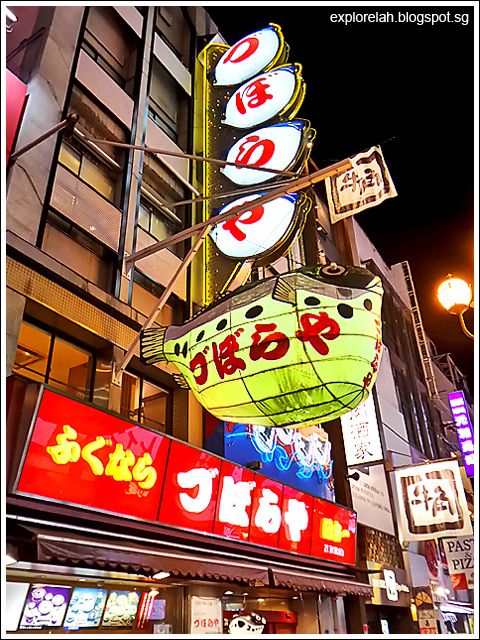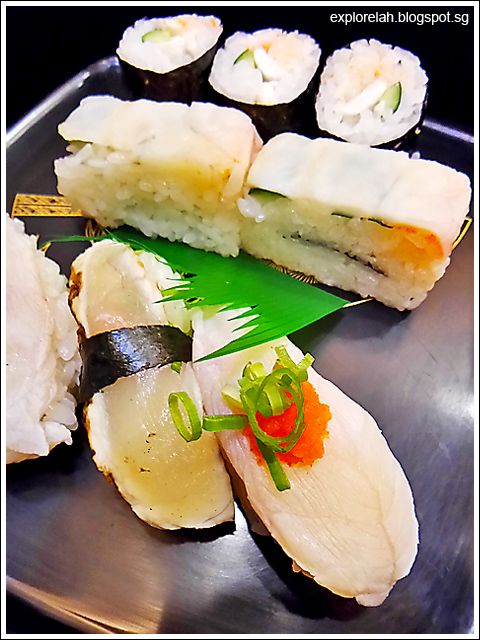Japanese cuisine may have spread to major cities all over the world but there's one dish that remains tightly guarded within the home of the samurais. That deadly fish dish is called fugu, a Japanese delicacy that both warns and warms the palate of any daredevil gastronome.
Fugu is the Japanese name for pufferfish (a.k.a. blowfish, globefish, balloonfish, and swellfish) and has its roots in a local term that means "swell up". In Chinese, pufferfish is called 鰒鱼 fù yú and is often nicknamed 河豚 (meaning "river piglet"), so it is common to see these Chinese characters used in restaurant signages and menus in Japan. If I have my way, I would nickname it "durian fish", but "river piglet" befits the adorable and comical way the fish looks when it puffs up with water (in sea) or air (on land) when threatened. And I have a soft spot for piglets, but that's another story.
I was hoping to get a taste of fugu during this Japan trip, not because I have a death wish, but I was curious to find out why, when there is no lack of safe for consumption fish species in the oceans, the Japanese would risk poisoning by biting into this forbidden fruit.
Although Tokyo has the highest number of fugu restaurants numbering around 3,000 throughout the city, we didn't come across any. Neither did we see the giant pufferfish lanterns, a sure sign that advertises fugu restaurants, in Kyoto or Nara so you can imagine the fireworks that went off in my gut when I sighted the ballooned fish hanging on a shop's facade in Osaka's glittering Dotonbori street!
 |
| I didn't understand a word of the Japanese signboard but the fugu lantern was enough to hook and reel me in. On closer inspection, the English name of this restaurant is Zuboraya Dotonbori. |
A License to Slice
In order to serve fugu, chefs must go through a 2-year licensing course where they study and practice disarming the poisons from fugu for human consumption. The most poisonous parts of a pufferfish are the liver, ovaries, testicles, entrails and eyes, which the chefs must skillfully remove without contaminating the flesh of the fish.
The preparation protocol is that all the poisonous organs that are removed must be deposited inside a plastic bag which is then sealed and placed into an air-tight container so that they don't mix with other wastes.
At the end of the licensing programme, the apprentices have to go through a stringent certification exam which qualifies them as safe hands to eat fugu from.
Die While Alive
What makes dining on pufferfish so deadly is the presence of a class of neurotoxins known as tetrodotoxin in its organs. Different pufferfish species have varying concentrations of the toxin in different parts of the body.
Tetrodotoxin is colourless, ordourless and resistant to heating and is 1,000 times more deadly than cyanide, causing death through paralysis of the muscles and organs in the body, especially the lungs, leading to breathlessness and suffocation. Victims remain mentally conscious and alive but are unable to move their bodies as tetrodotoxin invades. The toxin paralyses the diaphragm and causes a shut down of the respiratory system. What follows is a terrifying death where you are fully aware of what's going on around you but slowly dying from asphyxiation.
Although tetrodotoxin is very dangerous, the irony is that it is that which makes fugu such a thrilling dish, not because of the potential of death, but the numbing, tingling sensation on the tongue and lips when just the right amount of the poison is present.
Safe-to-Eat Farmed Fugu
An interesting fact I found out is that pufferfish aren't actually poisonous. They acquire the tetrodotoxin from their diet of starfish and shellfish. These food sources contain a bacteria that causes tetrodotoxin during metabolic processes and the pufferfish is able to harness the poison and store it as a biological defence. Does that mean I should stop eating starfish and shellfish too?
Did you frown incredulity at the mention of starfish and thought maybe I made a mistake because starfish is not known as a culinary ingredient in Singapore? Well, I didn't. In Hong Kong, and maybe some other parts of the world, I've seen dried starfish sold as condiments to flavour soups. I bought two packets and experimented in the kitchen before. They imparted a mildly distinct taste in my soups that made me imagine what sucking on a moist seashell must taste like with every spoonful.
By understanding how pufferfish acquire tetrodotoxin through what they eat rather than producing the poisons themselves, there are now fugu farms in Japan that breed and rear poison-free pufferfish. A lot of what's supplied to fugu restaurants nowadays are the farm-bred versions of the wild species where their feed is devoid of bacterial tetrodotoxin contamination.
 |
| Fugu sushi was another way our taste-buds were led to experience pufferfish differently. |
There are over 100 species of pufferish worldwide but only about 20 species are approved for consumption in Japan after a trial-and-error that first took place over 2,000 years ago. Today, Japan is a pioneer is developing fugu that is devoid of poison through farming and eliminating tetrodoxin-inducing food sources. Despite this safety guarantee, fugu is one dish that can never be served to the emperor of Japan.
Culinary Cult Culture
So what's the fun of eating "safe" fugu if it is just like any other fish? Admittedly, I was a tad disappointed that my fugu meal was most likely from farmed fish rather than from the ocean. I didn't verify with the restaurant but I assumed farmed fugu is used because of its prevalence due to its safety for consumption. And the price was more affordable. Wild caught fugu would've cost more.
 |
| Fugu Udon... my first encounter with cooked fugu and I found myself drawn to the firm texture of the meat. |
As a point of reference, the Tiger Pufferfish (Torafugu) which is an unfarmed wild caught species and considered a gourmet (the "kobe beef" of fugu) costs about 22,000yen (S$280) per kilogram; while the Mafugu, a schooling species (you catch one, you catch many) and also farmed, costs less than half that price.
As you can imagine, the fugu connoisseur would hunt down premium or secret restaurants serving Torafugu while tourists like me get all excited over farmed fugu meat. Wild or farmed, fugu has a cult-like following in Japan and is the most exotic food to eat in the country.
Is Fugu Worth the Hype?
Taste-wise, I find the fish's meat to have a firm chewy texture and kinda sweet. It is pleasantly mild flavoured and easy on the palate but nothing exceptional. Without the tingling sensation that tetrodotoxin causes, the poison-free version of fugu is just like eating any other fish.
 |
| Fugu tempura. |
 |
| Raw chunks of fugu to be cooked in a hotpot. |
Fugu is famed because of how it numbs the mouth because of tetrodotoxin and people risk death to enjoy it. So the toxin-free version of the fish lacks any real distinguishable draw to eat it really. It is like looking at a shark in an aquarium.
For the amount we paid for the dinner for two, I would say it is reasonable just to try what a fish that is not commonly found in most markets around the world taste like. I wasn't hooked on this dish but it sure makes for an interesting travel tale to tell given the pufferfish's dangerous reputation. Give it a try when you're in Japan!





No comments:
Post a Comment